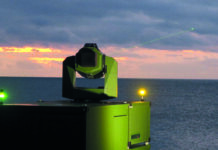Conventional weapons, from a simple knife to a sophisticated missile, are primarily designed to kill the enemy and destroy his capabilities. By contrast, less-lethal technologies are devices designed to be less likely to cause death.
Less-lethal weapons are commonly used in policing and public order situations where the use of lethal force is either undesirable or prohibited. The military also occasionally employs less-lethal technology in situations where the rules of engagement necessitate minimum casualties or where the use of conventional force is restricted. In doing so, they try to minimise the risk of (lethal) casualties, although death and permanent injuries can never be excluded (hence the term, less-lethal weapons and not non-lethal weapons). In peacekeeping and operations undertaken to maintain stability, less-lethal weapons have proven to be very effective and to have a deterrent effect on the target. Non-lethal technology is often used for the purpose of self-defence, to channel the movement of people and to limit access to restricted areas. It is also very effective in controlling riots, prisoners, refugees and (domestic) crowds in general.
Classical non-lethal technology
Some devices in the non-lethal weapons’ arsenal form part of the standard equipment used by police services and (para)military forces which are used on a daily basis and therefore commonly known to the general public.
Water cannons
Water cannons are devices that shoot streams of water at high velocity and over a long distance at a group of people or individuals unwilling to comply. They originate from water cannons that were formerly used on fireboats shortly after the First World War. The cannons were later installed on fire trucks. The first use of a water cannon to disperse a crowd was in Germany in the early 1930s. Since then, police forces have used the water cannon to disperse crowds of people or to prevent them moving to certain positions. There’s little risk of (lasting) harm, but the pressure of the water can still cause severe injuries to the eyes and, in the most extreme circumstances, cause death.
During The Troubles in Northern Ireland in the 1960s and 1970s, the police added pink dye to the water to make it easier to identify and arrest rioters later. The UK has abandoned that practice, but countries such as Korea, Indonesia and China (recently in Hong Kong) still make use of this simple but effective method to mark the protesters.
Modern water cannons are also capable of adding tear gas to the water and experiments are ongoing to conduct electricity through the water stream for the so-called ‘electrified water cannon’. Portable water guns, with adjustable volumes of water, nozzle speed, pressure and power of impact, are also in an experimental stage of development.
Tear gas
Tear gas is a so-called ‘lachrymator agent’ (‘lacrima’ is the Latin word for ‘tear’), a chemical agent that stimulates the nerves of the lacrimal gland in the eye to produce tears. After inhalation, it can cause severe eye and respiratory pain, skin irritation, bleeding and temporary blindness. In riot and crowd control situations, tear gas is launched by means of a grenade. The grenade then releases the gas in the middle of the crowd. When used for self-defence purposes or to bring a suspect under control, a specific type of tear gas known as ‘pepper spray’ is used: a temporarily disabling aerosol that is composed partly of capsicum oleoresin (a derivative of cayenne pepper, hence the name) that causes irritation and blinding of the eyes and inflammation of the nose, throat, and skin. Pepper spray is often released through a spray can at a short distance from the target. Although not meant to kill or to physically injure the target, tear gas and pepper spray may cause serious injuries and even death, be it from the grenade used to launch the tear gas or by the extreme suffocating effects of pepper spray. Recent research has indicated that the long-term effects of the inhalation of tear gas and pepper spray are not as innocent as they seem. Although tear gas is deployed for (domestic) riot control by law enforcement agencies and military personnel, its use in warfare is prohibited by various international treaties.
Rubber bullets
Rubber bullets are also very popular among police and military forces for riot control and to disperse crowds. They were originally developed in the 1960s by the British Ministry of Defence to be used against protesters in Northern Ireland during The Troubles. They were first used in 1970. Although the name suggests that rubber bullets are made out of rubber, in reality, the bullet has a metal core with just a rubber coating around it. Its less-lethal effect also stems from the lower speed at which rubber bullets are fired. Rubber bullets come in all sorts of forms, but rubber has always been a minority component. Since rubber tends to bounce uncontrollably, rubber projectiles have largely been replaced by other materials, such as soft polymers, plastic and wax, but the term has survived. To incapacitate the target, rubber rounds rely on the transfer of kinetic energy to cause a very painful trauma at impact. Although they are far less lethal than full metal bullets, they can still cause serious injuries such as blindness, permanent disability and death, especially when the bullet is fired at the head of the victim at short range. To prevent fatal casualties, the first rubber bullets were designed to be fired at the ground and then hit the target with a ricochet effect. Other non-lethal bullets are supposed to be fired at the lower body in order to prevent (possibly lethal) head injuries.
Derived from the rubber bullet-concept are ‘beanbag’ rounds, consisting of a small fabric ‘pillow’ filled with lead and weighing about 40 grams. When fired, the bag is expelled at around 70 to 90 m per second. It spreads out in flight and distributes its impact over about six square centimetres of the target. It delivers a blow that causes minimum long-term trauma and no penetration, but that will result in a muscle spasm or other reaction to briefly render a violent suspect immobile. However, it can still cause serious injury and death.
More recently, high-velocity paintball guns are used to launch less-lethal rounds. Rubber bullets releasing an electroshock effect are also a recent invention. They release kinetic and electric energy at the same and are a combination of a rubber bullet and a taser.
Tasers
Tasers are well-known electroshock weapons used for subduing a person by administering an electric shock that disrupts the superficial muscle functions of the body. Some electroshock weapons administer an electric shock by direct contact (like stun guns and stun batons), but the most known is the taser, which fires projectiles that administer the shock through a thin, flexible wire. The taser was initially developed for use by civilian police, but is now also widely used within the US military and by private citizens in the US for self-defence purposes.
New developments
In recent years, tensions have been rising all over the world: think of the Black Lives Matter riots in the US, the Yellow Vest protests in France and the (often violent) protests against the anti-COVID-measures all over the (mainly western) world. There have been severe riots in Myanmar, the Republic of South Africa and also in Hong Kong against the usurpation of powers by Beijing. At Europe’s borders, in Ceuta (a Spanish enclave in North Africa), in Hungary and in Greece, police forces often clash with large groups of migrants who try to illegally enter the European Union. The threats are high and real, but governments have become more aware of their reputation, at home and abroad, and have become more eager to prevent the use of lethal force if the same objective can be reached without having dead bodies shown on the evening news. They actively support the development of non-lethal weapons to provide a range of options between talking and shooting. As a consequence, police and military forces are looking for a broader range of less-lethal weapons that can be deployed against all kinds of troublemakers, that are more life-conserving, environmentally friendly and cost-effective. Business and research in the field of non-lethal technology is booming and a wide range of improved or brand new less-lethal weapons is under development.
Sponge grenades
Sponge grenades are bullet-shaped grenades with a foam rubber nose and a high-density, plastic projectile body ring. They are used to target individuals (instead of indiscriminately targeting groups) and cause no permanent damage, although cases of broken bones, head wounds and permanent damage to the eyes are recorded. If used at a distance less than ten metres, they may even prove fatal. In recent years, they have been used by the US, the Hong Kong police and Israel to disperse crowds, although it is best used when aimed at a particular individual.
The development of less-lethal hand grenades is also encouraged: grenades with blunt trauma and flashbang effects (stun grenades), ‘sting’ grenades with rubber shrapnel, and grenades designed to release chemical irritants such as tear gas. Less-lethal hand grenades are known to have been used in Gaza, Kenya and Egypt.
The United States Marine Corps has developed an active denial system in which a high energy micro wave is used to rapidly and continuously heat all living matter in a certain target area. During the duration of the beam, intolerable pain is inflicted on the target through the heating of the skin, but no lasting damage occurs.
Tests with Very Low Frequency Sound have proven to be successful in causing nausea, disorientation, loss of bowel control and vomiting. The acoustic waves can also easily penetrate buildings and vehicles, but when applied too long, they can cause internal organ damage and consequently death.
Other directed energy weapons that offer possibilities for less-lethal usage are the Ultraviolet laser that could immobilise living targets and even cars at a distance without any direct contact. The pulsed energy projectile creates a small amount of exploding plasma and a pressure wave that stuns and immobilises the target while causing considerable pain because the nerve cells are affected. The same technology could also be used to counter UAVs and drones.
A dazzler is a directed-energy weapon that uses intense directed radiation to temporarily blind or disorient the target, optical sensors and human vision alike. Most of the contemporary systems use lasers to blind the target and are man-portable. They reportedly were used by the Hong Kong police against demonstrators.
In the field of the chemical agents, like gases and sprays, spectacular developments are taking place: scent-based weapons producing strong, sewage-like odours that force people to leave an area and that stick to their body and clothes, facilitating the later identification of the rioters. Experiments with psychochemical weapons that use drugs like LSD to disorient the target are taking place, but since the effects on the target are highly unpredictable, their employment outside the laboratory seems unlikely. Sleep gas – used by the Russian security forces during the 2002 Moscow theatre hostage crisis that had a dramatic showdown – offers great possibilities for use in police and military operations. Sticky foam, on the other hand, was tried with some degree of success, but its use on the battlefield remains a complicated matter.
Conclusion
This overview has simply highlighted the possibilities of less-lethal technology, now and in the foreseeable future. No doubt, this type of weaponry will be used more and more, at home against domestic uprisings and abroad in military operations. However, besides the technical and tactical difficulties, there are also a number of moral and legal issues that need to be solved before less-lethal weapons will really break through, especially regarding their military use.




